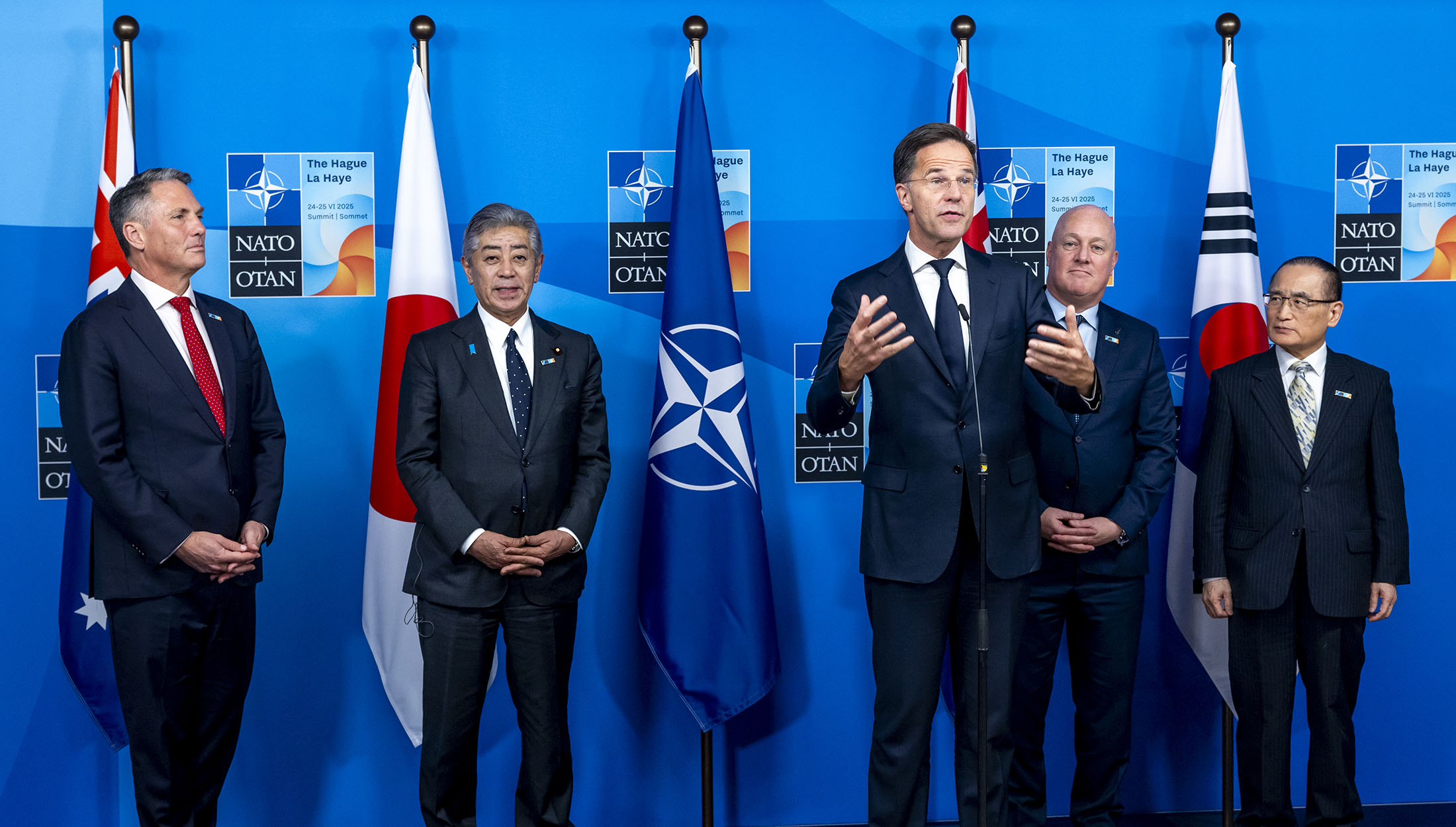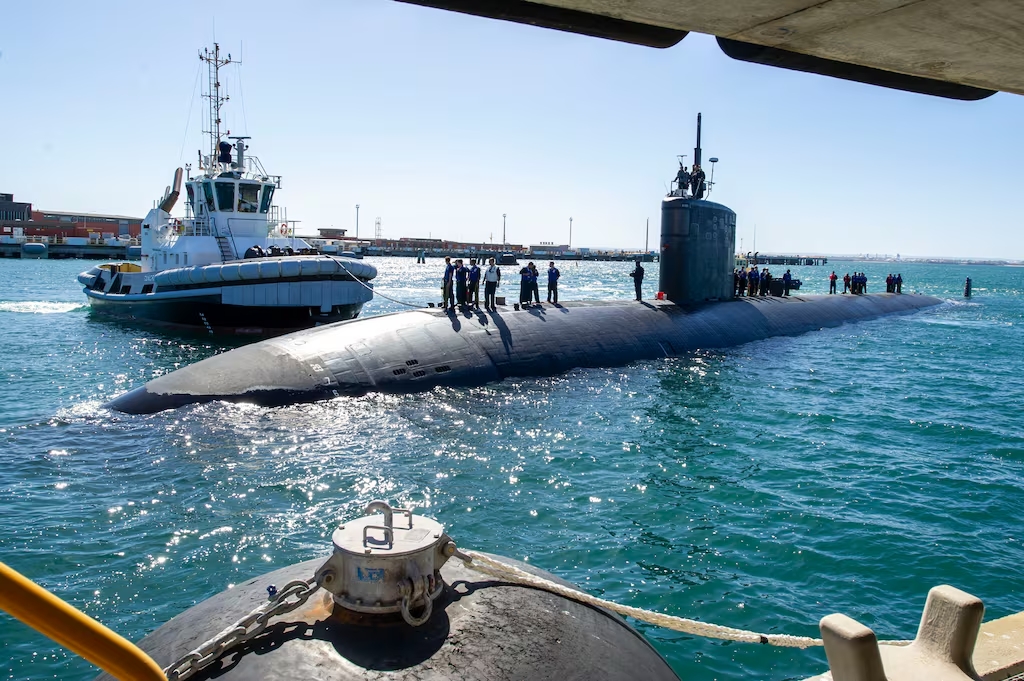
From left: Richard Marles (Deputy Prime Minister, Australia), Takeshi Iwaya (Minister of Foreign Affairs, Japan), NATO Secretary General Mark Rutte, Christopher Luxon (Prime Minister, New Zealand), Wi Sung Lac (National Security Advisor, Republic of Korea) meet at the NATO summit in The Hague, Netherlands, June 25, 2025. (Photo: NATO)
In the post-World War II period, the U.S. maintained nearly uncontested supremacy over the vast Asia-Pacific region. Under the San Francisco System, or the ‘Hub and Spokes’ architecture, the U.S. established military alliances, provided economic assistance, and proactively engaged with the region. The strategic foundation of U.S. policy relied on both bilateral and multilateral defense agreements, such as those with Japan (1951), South Korea (1953), the Philippines (1951), Australia, New Zealand (collectively known as ANZUS, 1951), and Thailand (1954).
The U.S. provided economic assistance and played a role in the region’s reconstruction. It supported Japan through the Dodge Plan to stabilize its economy and, following the Korean War (1950-1953), offered aid to Seoul. The U.S.-led IMF and the World Bank also assisted various countries. Washington pressured its European allies to relinquish their colonies in Asia. U.S. economic and technological assistance contributed to the rise of the Asian Tigers, South Korea, Hong Kong, Singapore, and Taiwan, from the 1960s to the 1990s.
The U.S. is now reversing these policies. While this reversal trend had started earlier, the policies of President Donald Trump during his second term, beginning in January 2025, accelerated it. His ‘America First’ policy is reshaping U.S. relations with Asia-Pacific countries in defense, alliance patterns, and economic domains.
Trump is linking the U.S. commitment to Asia-Pacific allies with ‘higher costs, more demands, and inconsistent conditions.’ He pushed allies to increase their defense budgets to 5 percent of GDP and bear the lion’s share in common security. Trump imposed heavier tariffs on India for purchasing Russian arms and oil, marking the first significant blow to U.S.-India relations in recent times. His policies sparked public dissatisfaction and diplomatic tensions in many countries of the region. For instance, Japan cancelled its planned 2+2 meeting with the U.S. set for July 1; Australia’s Prime Minister Anthony Albanese publicly rejected U.S. calls for a significant boost in defense spending; top leaders of Japan, Australia, and South Korea skipped the NATO summit in The Hague and instead sent lower ranking officials; South Korea’s defense ministry formally rejected the demand for an increase in defense budget.
Besides straining bilateral relations, Trump’s policies have affected at least two U.S.-led minilateral security frameworks: the Quad (Quadrilateral Security Dialogue), which includes Japan, the U.S., India, and Australia, and AUKUS (Australia-United Kingdom-United States). The Quad was established in 2007 to coordinate humanitarian assistance, disaster relief, and strengthen maritime security in the Indo-Pacific region. After its revival in 2017, the Quad aimed to deepen strategic cooperation on maritime security, critical infrastructure, connectivity, supply-chain resilience, and emerging technology to promote a ‘free, open, and rules-based Indo-Pacific,’ implicitly opposing China’s policies. However, by alienating all other members, the future effectiveness of the mechanism is now uncertain.
Similarly, AUKUS faces an uncertain future. Launched in 2021, AUKUS was designed to equip Australia with advanced nuclear-powered submarines and to establish a trilateral framework for collaboration in cutting-edge areas such as cyber, artificial intelligence, quantum technologies, and undersea warfare, with the strategic intent to counter China’s growing military influence in the Indo-Pacific region.

The Los Angeles-class fast-attack submarine Annapolis pulls alongside Diamantina Pier at Fleet Base West in Rockingham, Western Australia, on March 10, 2024. (MC2 Kaitlyn Eads / U.S. Navy)
The Pentagon is reviewing the AUKUS agreement on sharing nuclear-powered submarine technology with Australia and the United Kingdom.
In June 2025, the U.S. Department of Defense initiated a formal review of the A$368 billion (approximately US$240 billion) AUKUS deal, assessing whether it aligns with the Trump administration’s ‘America First’ agenda and U.S. defense industrial interests. The review, led by Under Secretary of Defense for Policy Elbridge Colby, is expected to be completed in the next few months. Both the UK and Australia have publicly emphasized their commitment to AUKUS but acknowledge concerns about the project’s future amid U.S. policy uncertainty. The disconnect in U.S. relations with key strategic allies Japan, Australia, and India raises doubts about the future of both the Quad and AUKUS.
In the economic sector, unlike the post-WWII U.S. policy of economic assistance and opening markets, the Trump administration adopted protectionism and imposed a series of steep tariffs starting from April 2, the so-called ‘Liberation Day.’ Although the U.S. has signed trade deals with some countries and is negotiating with others, all Asia-Pacific countries have been deeply affected by these tariffs. Even in the final trade agreements, U.S. tariffs are significantly higher than those that existed before April 2. For instance, the tariffs with Japan are set at 15%, with South Korea at 15%, and with Vietnam at 20%, compared to what existed before ‘Liberation Day.’
Prior to the tariffs, the Trump administration significantly reduced U.S. global foreign aid, including cuts to USAID funding, global health programs, contributions to the World Food Program, climate change, and public broadcasting. In June 2025, the Trump administration submitted a report to Congress that proposed cutting US$8.3 billion in foreign aid in key areas. While the Trump administration’s approach has its own rationale, these tariffs and aid cuts have severely impacted especially vulnerable economies and small countries. For instance, small Pacific Island Countries faced the brunt of simultaneous aid reductions and heavy tariffs.
The Trump administration implemented these significant changes quickly, unilaterally and without consulting regional countries. This caused a state of panic for many nations. Although most countries chose not to respond, fearing further retaliation, their discontent was evident.
The post-WWII security architecture in the Asia-Pacific had become structurally obsolete, mismatched with the rapid changes in the region; policies of the Trump administration accelerated its erosion and fragmentation. Expressing concerns against U.S. policies by allies such as Japan, South Korea, Australia, and India, the fate of the Quad and AUKUS signals this erosion. Many regional countries believe that if they have to bear the burden of their own defense and pay steep tariffs to access the U.S. market, it would be better to adopt policies that align with their own national agendas rather than toeing the U.S. line.
The evolving pattern indicates that major regional countries will increase their defense budgets due to uncertainties surrounding U.S. commitments. At the same time, they will reassess their relations with others, particularly with China, against whom they had sought U.S. backing. Engaging with China independently of U.S. security commitments would provide them with a new perspective. This trend had already begun even before Trump’s second term. Japan, South Korea, Australia, and India, among others, had started to warm up to China by 2024.
Furthermore, the growing middle power status of these countries compels them to develop their own agency and nationalistic outlook rather than being seen as secondary players in the U.S. Asia-Pacific strategy. For example, Japan has its own vision that it aims to use to shape regional politics. Similarly, India has long maintained strategic autonomy and a preference for minilateralism. Once an externally imposed security order in the Asia-Pacific weakens, it could lead to geoeconomics superseding geopolitics, and minilateralism and multipolarity superseding unilateralism.
Many analysts hold Trump responsible for the shifts (read decline) in U.S. influence in the Asia-Pacific. A deeper examination shows that Trump is an effect, not the cause. The U.S. represents a typical case of the ‘rise and fall of great powers,’ a common theme in human history. The overstretched global hegemony of the U.S., exposure of its moral bankruptcy as seen through its blind support for Israeli genocide in occupied Gaza, the mounting debt, and compounding economic challenges necessitated structural changes in U.S. policies. Trump is trying to address these accumulated American problems in his own way. The decades-old U.S. influence in the Asia-Pacific is changing. Who will fill the void and what the future security structure of the region will be, remains to be seen.
